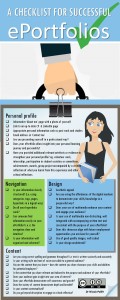To begin our discussion of how to build an e-portfolio, we’ll start with the overarching steps towards e-portfolio completion. According to Karaoglan & Kisla (2011), a student creating an e-portfolio should follow these steps:
- Collection: collecting artifacts depending on purpose, audience, and the future use;
- Selection: selecting artifacts that reflect the learning objectives;
- Reflection: stating the impact on one’s learning;
- Projection: based on learning setting goals for the future and
- Presentation: structuring and publishing the selected artifacts to communicate with others.
These steps allow students to find and choose artifacts that are important to them, to determine the final purpose of the e-portfolio, reflect upon the artifacts and their place in their learning history, and present their goals for the future included in the presentation as a whole. These steps will help guide the process as it unfolds to make sure students are on track. When they are unsure as to the next step in their path, reference these and it should align them back to the original goal and purpose of the e-portfolio.
Similarly, Jenson & Treuer (2014) list these steps:
- Collection: collecting relevant artifacts that demonstrate learning outcomes;
- Self-regulation: being aware of behaviour students can control and exercising that control for learning;
- Reflection: contextualizing the meaning and significance of learning, consistent with established goals and values;
- Integration: synthesizing and transferring learning to any number of situations;
- Collaboration: Participating in community to build knowledge and skills on a foundation of existing knowledge.
As the educator there are steps that you can follow to help ensure that the e-portfolio is relevant to your students and their needs. Karaoglan & Kisla (2011) also state the following steps to aid the educator:
- Provide continuous mentoring or coaching
- Provide faculty support
- Be clear about the purpose of using the EP
- Select assessment tasks that are clearly aligned or connected to what has been taught.
- Share the scoring criteria for the assessment task with students prior to working on the task.
- Provide students with clear statements of standards and/or several models of acceptable performances before they attempt a task.
- Encourage students to complete self-assessments of their performances.
- Interpret students’ performances by comparing them to standards that are developmentally appropriate, as well as to other students’ performances.
Examples and checklists
This infographic walks through the checks a student should go through. Click for a larger image.
Image: Pallitt, N. (2014). A checklist for successful ePortfolios. OER: Open UCT.
This video documents an excellent example of an e-portfolio
Technical Resources
There’s no one right way or platform for an e-portfolio, but here are a few sites that will help you find what works for you and your class.
———————————
References
Karaoglan, B., & Kisla, T. (2011). How does e-portfolio align with new students’ educational aspirations? Paper presented at the 1-4.

 Follow
Follow